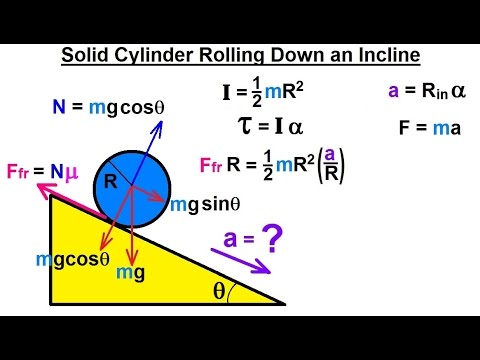Michel van Biezen
Visit http://ilectureonline.com for more math and science lectures!
In this video I will find the acceleration, a=?, of a solid cylinder rolling down an incline.
Next video in this series can be seen at:
https://youtu.be/rgswBzrrHl8
Source




Thank You Sir, It was So helpful.🙂
heavier cyclists roll down hills faster than lighter cyclists.. if mass cancels out, then how can we explain this phenomenon?
How is the friction force opposing the linear acceleration when it is only causing rotation?
can someone explain why there is friction? i thought rolling objects didn't have friction, only if it is slipping then friction acts?
I still think that the lagrangian approach is simpler and elegant, but i like this explanation too
I'm having a massive case of confusion after self-learning about rolling friction, and then coming back to this question. I have a couple of questions, if someone could help me clarify, I would greatly appreciate it:
1. The coefficient of friction in this question (and the friction force in this question), are they referring to static friction, which is what I thought the friction always is when rolling without slipping, or is it rolling friction? I know we didnt solve for u here, but if we had solved for it, would we consider it to be the coefficient of static friction, or would it be considered the coefficient of rolling friction?
2a. If it is the coefficient of rolling friction, can one say that rolling Friction = coeff. of rolling friction x Normal Force? Also, are we just ignoring static friction then?
2b. If it is not rolling friction, then it must be static friction (which is what I've usually seen). If so, how can we know when rolling friction applies vs. when your classic Fstatic = us x normal force is what must be done? Because if this question does deal with only static friction, I know exactly how to handle it, it's the same old friction problem, but how in the world do I apply rolling friction to this? The object is rolling, so rolling friction must be involved somehow I guess.
This is also leads to a similar scenario question I have as well:
3. I have a solid block on a flat surface, I kick it so that it has an initial velocity of 10 m/s. Given enough kinematics and force info, I can easily figure out the total displacement of the block, and I can also solve for the KINETIC coefficient of friction in this case (easy peasy). Let's just say, for the sake of simplicity, that the block traveled 10 meters before stopping.
If I have a ball of same mass and material as the block that is on the same flat surface, and I kick it horizontally such that it also starts with a horizontal velocity of 10 m/s just like the block, it moves linearly and also rolls until it stops, let's say no slipping.
Given enough kinematics and force/torque info, if I use linear kinematics, the linear displacement also comes out the same as the blocks displacement of "10 meters", but this doesnt seem right to me since some of the energy must have been used for rolling instead of translating. Would the linear displacement be the same for the rolling ball, or am I right in thinking that I am missing something? Regarding the force portion of the question, I can also solve for the friction force and/or the coefficient of friction. I would solve it considering STATIC friction only, with no consideration towards rolling friction (because that is all that I have been taught). But, by doing so, am I actually solving for the rolling friction force (and coefficient) or am I right in saying that I am solving for the static friction force (and coefficient)? If I am right about static, it again brings up the point of how would rolling friction apply here?
THANK YOU for your time and effort, future responders!
Thank you so much for the video, im 4 years late, but this was explained very clearly.
i did a question where the mass= 1.7kg and is on an incline at 37 degrees. i used your working and got the wrong answer but i'm not sure why
another way to solve problems like this is to use energy balances
can somebody help me to get the distance travelled
I don't believe in god but sir your are the god of knowledge 😭😭😭 almost every time I search for my school work I see brilliant explanations from your videos😭😭😭
Final answer is correct.
Indeed a=2/3*g*sin(theta) BUT the explanation has a mistake. On minute 1:22 he says "friction = myu * N" and this is not correct, need to be left as friction (f), no myu involved, no N involved.
Still, final answer is correct a=2/3*g*sin(theta).
Apologize in advance in case I'm wrong…
I have to conduct a research question for physics, I’m thinking on rolling motion, something in relation to a ball rolling down an inclined plane, any ideas? (How does?….what is the effect of…..)
Fucking legend. People like you make the world a better place!
Love you sir 🇮🇳
Hello, I am currently using this wonderful video as the theory behind a simple experiment we are doing as part of a high school research assignment. For his final solution, it seems that pnu is not a factor?! Does the frictional coefficient of the inclined surface not matter? This leaves me so, so confused.
How did you take static as limiting friction?
Thank you for not skipping even the smallest arithmetic steps.
The difficult part is to figure out what is the force causing the torque that gets the rod to roll. If you figure out , this is the friction force by the bank to the rod, the rest would be solvable.
thanks alot sir . How much is the work of friction force in this example ?
brilliant. thank you so much
I am teaching this right now to Eng Tech students . I really enjoy your explanation but have a question/comment this may be semantics but I am thinking of the work-energy equivalent. If friction is creating the torque and it is in the opposite direction to motion doesn't this contradict the concept of work? Wouldn't the upsetting force (the component of mg acting perpendicular to contact) be causing the torque and doing the work? If you look at the work required to roll the cylinder up the hill it becomes a bit more obvious. I would appreciate your thoughts since I am not physicist but a lowly engineer.
Thank you so much for this. My lecturer Ralph is really bad
Excellent
Only one word : OUTSTANDING TEACHING !!
Totally loved it. No doubts at all.! 👍❤️🐼
What would be the minimum coefficient of friction required for the disk to roll without slipping?
THIS IS WRONG. FRICTION IS NOT = uN BECAUSE IT CAN BE LESS!
I HATE THIS CHANNEL
Finally !!! This video help me a lot ! Thanks!
Nice video! The static friction force, however, isn't mu (static) times the normal force, since that is the maximum static friction force and there is no indication that static friction is pushing at its maximum value. You get the same result, though, since you eliminated mu. But if you leave the force of static friction as Fs you get the same result:
From the torque: R*Fs*sin 90 = I * alpha = (1/2 m R^2) * (a/R) so Fs = 1/2 m a
From the Forces in the down-the-ramp direction, mg sin (theta) – Fs = ma, so…
mg sin (theta) – [1/2 m a] = ma
So a = 2/3*g*sin(theta)
My professor did an awful job of explaining this, he even spent 3 lesson just going over this one problem. This guy is awesome, took my professor about 120 minutes, took him 6 1/2………..
Cảm ơn thầy.
Thanks teacher <3
It is assumed the object is rolling not sliding. In fact there are 3 cases:
1. μ > (1/3)tan(θ) : object stands still (?)
2. μ = (1/3)tan(θ) : object rolls (a = 2/3 * g * sin(θ))
3. μ < (1/3)tan(θ) : object slides while rolling (a > 2/3 * g * sin(θ))
My guess is that object doesn't abruptly go from 100% rolling to 100% sliding:
Sliding portion gradually increases as θ increases for a given μ.